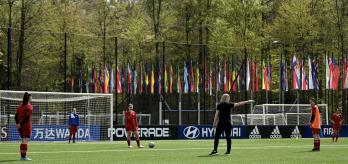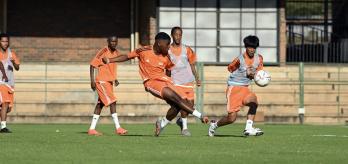This is a high-pressure strategy which involves pressing the ball during transition from attack to defence in an attempt to win it back as quickly as possible. While counter-pressing or gegenpressing can take place anywhere on the pitch, the focus of this article lies on regaining the ball in areas close to the opposition goal.
Key messages for carrying out this tactic
- defensive balance in possession;
- quick and organised reaction to loosing the ball
Defensive balance in possession
Preparation is an important aspect of counter-pressing. To be able to press the ball properly, players must be positioned in the correct areas before possession is lost. This requires concentration as well as the ability to make a quick mental switch from attack to defence. Defensive balance is key to winning the ball back, as if the players are not organised and the gaps between the units are too big, it becomes easier for the opposition to play over the press into the space between the lines to counter-attack.
In the clip below, from the England v. Scotland match at the FIFA Women's World Cup 2019™, England have five players either inside or on the edge of the box, and five others providing defensive balance. In this attack, England lose the ball in the Scotland penalty area, but their counter-pressing leads to a poor clearance by a defender, straight to an England player providing defensive balance outside the box. England score within seven seconds.
April Heinrichs, Head of FIFA's Technical Study Group for the tournament, said that "effective high pressure only works if you have a well-oiled machine", and the image above highlights the level of England's organisation which led to them regaining the ball high up the pitch and scoring within seven seconds of losing it. This correlates with the statistical evidence as according to the technical report, 61% of ball recoveries across the tournament occurred within seven seconds of the ball being lost.
Quick and organised reaction to loosing the ball
Another key aspect for any team surrendering possession is how they react. Counter-pressing must be quick and organized. Good organisation is vital in order to regain the ball when pressing. The counter-press may be led by the quick response of the players closest to the ball but other team members are integral to closing the space in a coordinated manner, with the whole team applying continued pressure until the ball is won. Otherwise, if a team is not organised correctly and the players are not working together, they will leave themselves vulnerable to a counter-attack.
In the example below, five Scotland players are pressing against five England players to win the ball back. This is an organised press after losing possession. The clip below shows examples of how Scotland manage to regain the ball within seven seconds of losing it. It is a prime example of a team showing the right reaction after losing possession and being organised to win the ball back.
Conclusion
The organisation of a team after losing the ball is a key factor in winning it back quickly.
This article has looked at examples of ball recoveries high up the pitch. Other areas highlighted included defensive balance both in and out of possession, although predominantly after losing possession, along with how quickly a team can win the ball back.
The average time for regaining possession at the FIFA Women's World Cup 2019 was seven seconds, so designing practices with this in mind could help your team develop a successful strategy.
Sun Wen, the FIFA Technical Study Group member from China, highlighted in the technical report for the 2019 tournament that "there was a clear attacking mindset, as teams displayed either high or medium-high defensive lines. Defending close to their goal was avoided where possible," which is another factor to keep in mind when teams are trying to regain the ball close to the opposition goal.
"Effective high pressure only works if you have a well-oiled machine"


































